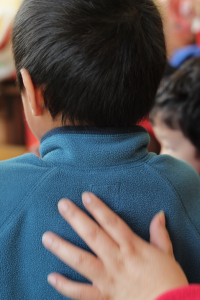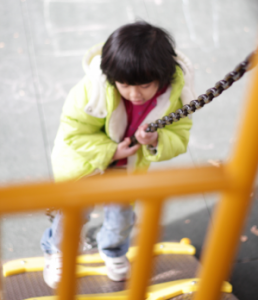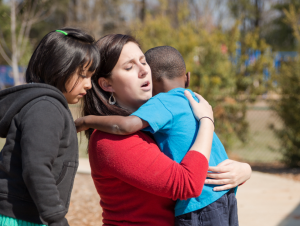13-3 Trauma-Informed Care
A – Trauma’s Impact

We are going to dedicate this section to thinking about trauma and caring for those who have gone through or are going through a traumatic situation. Caring for a child that has undergone trauma requires different behaviors and supports than a child who has not. Keeping a child’s trauma in mind and changing your behaviors to support that child is called trauma-informed care.
We’ll talk more about what trauma-informed care is in a moment, but first, let’s take some time to think about what trauma is and its impact.
Effects of Trauma
The Substance Abuse and Mental Health Services Administration compares the effects of trauma to a rock hitting the water’s surface. Here is an excerpt from page 30 of A Treatment Improvement Protocol: Trauma-Informed Care in Behavioral Health Services:
“Trauma is similar to a rock hitting the water’s surface. The impact first creates the largest wave, which is followed by ever-expanding, but less intense, ripples. Likewise, the influence of a given trauma can be broad, but generally, its effects are less intense for individuals further removed from the trauma; eventually, its impact dissipates all around. For trauma survivors, the impact of trauma can be far-reaching and can affect life areas and relationships long after the trauma occurred. This analogy can also broadly describe the recovery process for individuals who have experienced trauma and for those who have the privilege of hearing their stories. As survivors reveal their trauma-related experiences and struggles to a counselor or another caregiver, the trauma becomes a shared experience, although it is not likely to be as intense for the caregiver as it was for the individual who experienced the trauma. The caregiver may hold onto the trauma’s known and unknown effects or may consciously decide to engage in behaviors that provide support to further dissipate the impact of this trauma and the risk of secondary trauma.”

Reflection Point
“Trauma is similar to a rock hitting the water’s surface.”
This quote is from p. 30 of A Treatment Improvement Protocol: Trauma-Informed Care in Behavioral Health Services.
Does this description of experiencing trauma or caring for someone recovering from trauma resonate with you? Why or why not?
B – How to Support Children Who Have Experienced Trauma
Advice from Head Start
Video: Head Start-Trauma Smart (5:30)
The video Head Start-Trauma Start gives an overview of a Head Start program in Missouri specifically designed to support children who have experienced childhood trauma.
As you watch, see how early childhood educators support children who have experienced trauma.
Watch Head Start-Trauma Smart from Robert Wood Johnson Foundation on YouTube.

Video Debrief
What can early learning childhood professionals do to support children who have experienced trauma? (click to toggle expand or collapse)
Possible Answers
What can early learning childhood professionals do to support children who have experienced trauma?
Possible responses based on the video are that educators can:
- Notice children’s big feelings and identify and validate those for children.
- Encourage children to ask one another what kind of help they need.
- Teach stress-reduction strategies.
- Collaborate with families and other program staff.
- Take the time to care for themselves.

Reflection Point
Consider your responses to the following questions:
- What does it mean for a program to be trauma-informed?
- What are some elements of trauma-informed care?
C – Elements of Trauma-Informed Care
There are many components of trauma-informed care. We will briefly talk about only three of these pieces:
- Actively promote awareness and understanding of trauma and its impacts and recognize that certain behaviors, both challenging and seemingly benign, can be the result of trauma.
- Create a safe environment and work to form supportive relationships while considering each child’s unique experience with trauma.
- Use a strengths-based perspective and work to promote resiliency and to foster trauma-resistant skills.
Effects of Trauma

Trauma is common. About one in four children experience at least one traumatic event in the first four years of their life. As a person who works with children, you will encounter many children who are recovering from trauma. But it isn’t always easy to identify children who have suffered a trauma. Each child experiences trauma in their own way, and of course, each trauma is unique.
It is important to realize that trauma-related behaviors are the result of children adapting their behaviors to those traumatic experiences. In many ways, these behaviors may be an attempt to try and stay safe in the event of a perceived threat or to try to get attention in the only way that they are able to when under intense stress.
Children who have experienced trauma may show challenging behavior in a variety of developmental domains. Here are some areas where children may have challenges:
- Early trauma can have an impact on language development. Children who have experienced mostly instrumental language, or language that commands or directs a child’s behavior, such as “Be quiet,” “Put that down,” or “Stay there!” may use this same type of language with their peers. A child who uses this type of language may seem inflexible or demanding, but when considered in context, this behavior may be the result of a child not having the language skills to navigate more complex conversations and solve problems.
- Regulating emotions can also be difficult for children who have experienced trauma. Children may frequently feel afraid and stressed, which can manifest in challenging behaviors like being unable to control their impulses, aggressive behavior, misunderstanding cues, and showing insecurity in relationships.
- Children may also struggle to connect with their peers and have difficulty building relationships. For children who have experienced unsafe environments, this type of behavior can be a tool that they use to keep others at a distance to protect themselves emotionally and sometimes physically. Children who have experienced trauma may instead be very quiet and reserved, afraid to make themselves more visible in fear of punishment or adult retaliation.
- Some children may seem withdrawn, or have a hard time concentrating in class. Their stress response may be to draw inward and withdraw from the world around them. Or some sensory experience—a sound, a touch, or a smell—may trigger memories of the trauma and they may freeze or dissociate from the situation. Sometimes this behavior can even be misinterpreted as daydreaming.
Not all children who display these behaviors will have gone through trauma, but it is important to be aware that trauma can be the cause. Often, educators and other adults will link children’s difficult behaviors to disobedience rather than being rooted in their response to trauma.
If you suspect that trauma may be playing a role in a child’s behavior, seeking help from a supervisor can be important.
Creating Safe Environments
It is important to create a safe environment and foster relationship growth with all children in your care. Recognize that working with children who have experienced trauma can be challenging.
In an article for the National Association for the Education of Young Children (NAEYC), Katie Statman-Weil created this list of suggestions for helping children who have experienced trauma:
- Create and maintain consistent daily routines.
- Tell children when something out of the ordinary is going to occur.
- Offer children developmentally appropriate choices—often a loss of control is experienced during traumatic events. Empowering children by giving them choices can help them gain a sense of control and agency in their life.
- Anticipate difficult periods and transitions during the day, and offer extra support during these times.
- Use techniques to support children’s self-regulation.
- Understand that children make sense of their experiences by reenacting them in play or through interactions with peers and adults.
- Be nurturing and affectionate but also sensitive to children’s individual triggers.
- Use positive guidance to help all children.

Reflection Point
Take a moment to consider why each of the suggestions from the National Association for the Education of Young Children is helpful to promote resiliency in children who are recovering from trauma:
- Provide daily routines
- Give advance notice of changes
- Offer children choices
- Offer extra support for difficult transitions
- Support children’s self-regulation
- Allow children to reenact experiences
- Be nurturing, affectionate, and sensitive to possible triggers
- Use positive guidance
Think of any personal experiences you have had using these techniques or consider what using these techniques might look like in your early learning program.
D – A Strengths-Based Approach

It is always best practice to take a strengths-based approach when working with children and their families, but it is particularly important to do so when a child and their family are experiencing or have experienced trauma.
A child and their support network need to know that this trauma is not their fault and be encouraged to continue to lean on their current resources.
Taking a strengths-based approach means shifting the focus away from What is wrong with you? to What has worked for you? This helps to move the focus from solely on the trauma to adaptive behaviors and individual strengths that a family can lean on as they work through their recovery process.
Trauma and Resilience

As we discussed at the beginning of this section, a traumatic effect is like a rock hitting the water. The effects of the trauma ripple out, touching many aspects of a child’s life as well as the lives of those around them.
Your life is one of those lives that the ripples will inevitably touch. Take the time to care for yourself. You need to have enough personal reserves to be able to help others in need.
When caring for a child who is recovering from trauma, it is important to take a trauma-informed approach.
Many behaviors that are perceived as difficult are actually the result of a child adapting to scary or life-threating situations that have happened or are currently happening. Recognizing these behaviors as symptoms of the trauma is a crucial element of caring for children that have survived a traumatic experience.
Implementing trauma-informed care and taking a strengths-based approach helps all children in your program, even those who have not experienced trauma.
Recovery from trauma is possible. Both children and adults are resilient and can work through trauma when they have support.
In the next section, we will talk about resiliency and how to support children as they build this trait. First, we will do an activity where you will think about support networks.
 References
References
Briggs-Gowan, M. J., Ford, J. D., Fraleigh, L., McCarthy, K., & Carter, A. S. (2010). Prevalence of exposure to potentially traumatic events in a healthy birth cohort of very young children in the northeastern United States. Journal of Traumatic Stress, 23(6), 725-733.
Robert Wood Johnson Foundation. (2014, March 20). Head Start-Trauma Smart.[Video]
Statman-Weil, K. (2015). Creating trauma-sensitive classrooms. Young Children, 70(2), 72-79. [PDF]
U.S. Department of Health and Human Services, Substance Abuse and Mental Health Services Administration, Center for Substance Abuse Treatment. (2014). Trauma-Informed care in behavioral health services. Treatment Improvement Protocol (TIP) Series 57. [Manual]
EarlyEdU Alliance (Publisher). (2018). 13-3 Trauma-informed care. In Child Development: Brain Building Course Book. University of Washington. [UW Pressbooks]

